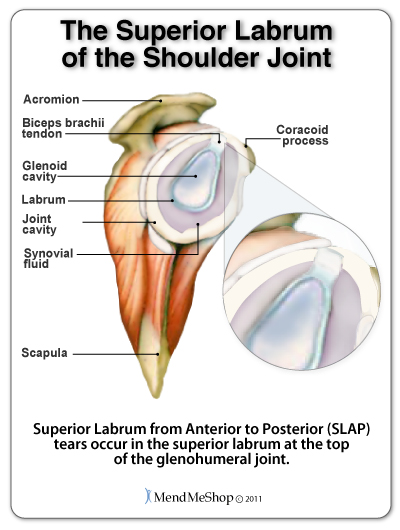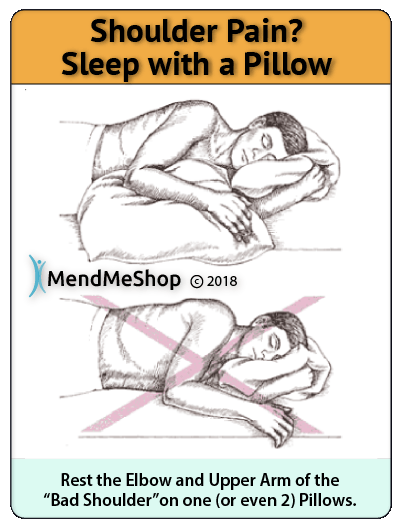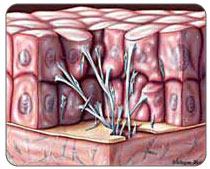The glenohumeral joint of the rotator cuff is where the humeral head (greater tubercle) meets the shoulder socket of the scapula, called the glenoid. The labrum is a piece of cartilage (called fibrocartilage), that is similar to the meniscus in your knee, which forms a cup within the joint for the humeral head to sit in. When this fibrocartilage tears, it is called a SLAP (Superior Labrum from Anterior to Posterior) tear or lesion.

This joint is considered a ball and socket joint - however the 'socket' is not as deep as similar joints in your body. Instead, the humerus sits against the glenoid cavity similar to how a golf ball sits on a tee.
Since the ball does not fit directly inside the socket of the glenohumeral joint, it is the labrum, tendons, and ligaments that hold the ball of the humerus against the glenoid fossa. These connective tissues provide stability between your scapula and your humerus.
The labrum (also called the glenoid labrum) is a very important piece of cartilage that forms a ring around the outer edge of the shoulder socket (glenoid cavity), making the socket deeper for the humeral head to fit into.
A SLAP tear, or Superior Labrum from Anterior to Posterior lesion, usually occurs when there is a traumatic injury to the shoulder. As the name suggests, a SLAP tear occurs at the top (superior) of the labrum running from the front (anterior) to the back (posterior) of the joint cavity. The long head of the biceps brachii tendon (also called biceps tendon) attaches inside the glenohumeral joint at the superior labrum, where a SLAP tear is located. As a result, the biceps tendon may also be damaged when a SLAP tear occurs.
An injury to the labrum, or any of the other stabilizing tissues, can cause the joint to weaken, misalign and/or become unstable. This leaves the rotator cuff at further risk of injury. The tendons and bursae can become pinched, excess stress can be placed on tendons and ligaments, and/or the weakened rotator cuff does not function properly.
With a SLAP tear, the amount of damage to the labrum can vary. The type of tear is classified as type 1 to 4 depending on the severity of the tear, with 4 being the most severe.

Degenerative fraying, and possibly a tiny tear, of the superior labrum. The edges of the labrum become rough but it remains attached to the glenoid cavity. This is usually a result of the cartilage becoming brittle with age.
The superior labrum is torn away from the glenoid cavity leaving a gap between the cartilage and the bone. The tear can occur from the biceps tendon forward (anterior), from the biceps tendon backward (posterior), or along the entire top of the labrum (anterior-posterior). Type 2 tears are the most common SLAP tears and are usually a result of an injury, such as a shoulder dislocation.
A 'bucket-handle' tear at the top of the labrum which leaves a flap of cartilage loose at the top of the shoulder joint. The torn cartilage may get caught within the glenohumeral joint causing a locking, clicking, or popping feeling. Generally, you doctor will recommend arthroscopic surgery to remove the 'bucket handle' section of the tear and to reattach the remainder of the detached labrum.
An extension of the SLAP tear into the biceps tendon. A Type 4 tear requires arthroscopic surgery to reattach the labrum to the glenoid cavity (SLAP repair) and suture the biceps tendon (called a biceps tenodesis).
This is another type of tear to the labrum but it doesn't occur at the superior, or top of the labrum and is therefore, not referred to as a SLAP lesion. A Bankart tear occurs to the lower, front area of the labrum and can extend upwards. It may also occur along with a Hill-Sachs lesion, which refers to a damaged humeral head, and/or a separation of the biceps tendon at the rotator cuff.
Symptoms common to a SLAP tear include:

If the tear is extensive (i.e. Bankart lesion) the chance of the shoulder becoming dislocated increases.
Like many shoulder injuries, SLAP tears are usually a result of a fall directly on the shoulder or falling on an outstretched hand. Repetitive or forceful overhead movements can also cause Superior Labrum from Anterior to Posterior tears. Therefore, participating in sports such as volleyball, tennis, and baseball can put you at risk.
Most Type 1 and 2 SLAP tears can be treated with non-invasive therapies such as Circulation Boost(TShellz Wrap®). Surgery is usually performed in the case of Type 3 and 4 tears so the torn labrum can be reattached to the glenoid cavity or other part of the labrum it was torn away from. Following surgery, the use of a Cold Compress or Ice Pack and a Shoulder TShellz Wrap® will reduce pain, inflammation, scar tissue and healing time!

The trick to treating your SLAP tear, improving your range of motion, and getting your shoulder back in the best possible condition you can is to improve elasticity and actively try to reduce scar tissue in and around the SLAP tear - this is an area where Circulatory Boost can help! If you heal your SLAP tear properly and treat scar tissue build up, your chance of re-injury or chronic shoulder conditions later on is much lower than average.
There are healing tools that can help treat your SLAP tear and speed up the healing process so you can get back to a life without pain and risk of further injury. Circulatory Boost will treat scar tissue and promote blood flow to heal your labrum faster and more completely than other conservative treatment methods available. Circulatory Boost is best achieved through the use of the TShellz Wrap®.
To decrease inflammation and relieve the pain of a SLAP tear doctor's recommend cold compression. Cold compression within the first 48 - 72 hours of a tear, after any strain or re-injury, or following surgery is effective at relieving pain and swelling while limiting the amount of damage done to your tissue. In addition, cold temperature can reduce, or even eliminate, the need for NSAIDs that affect your entire body unnecessarily.
Cold works by interrupting and slowing nerve and tissue function in the injured area and reducing swelling that can block blood vessels. This is important because once blood vessels are blocked or damaged, they can no longer carry oxygenated blood through your labrum and tissues begin to break-down. Without cold compression damage continues as tissues break-down - they cannot get the oxygen they need to survive. By limiting the amount of damage done to your tissue, you also limit the amount of healing that needs to occur. This is a very important step to heal your SLAP tear faster and with less pain!
Application of a Cold Compress or Ice Pack reduces tissue damage. Furthermore, because cold will numb the nerves, the wraps also reduce pain!
After severe inflammation and swelling is reduced you can begin to treat your shoulder with Circulation Boost (using a Shoulder TShellz Wrap®). The Shoulder TShellz Wrap® will increase the amount of blood that flows naturally to your shoulder to nourish soft tissue in and around your labrum to speed healing.
The glenohumeral joint naturally receives a limited blood supply and when you stop moving your shoulder because it hurts, the blood flow drops even further, limiting your body's natural ability to heal itself. By treating the area of your rotator cuff with a TShellz Wrap® you can increase your body's blood supply to the shoulder and increase your body's natural healing power.
When using a Circulatory Boost, tissues are safely and gently stimulated. Your body responds with a rapid increase in blood flow to the area, increasing the supply of oxygen and nutrients to injured tissue to promote healing. Our Shoulder TShellz Wraps® provides effective, non-invasive, non-addictive pain relief and healing with no side effects.
In addition, the improved blood flow whisks away dead tissue and toxins that have built up from your SLAP tear. When you stop moving your arm and shoulder due to shoulder pain, your muscles and other tissue can become weaker and dead tissue and toxins in the area can cause further tissue deterioration - this can lead to atrophy. By clearing the area of toxins and increasing the amount of oxygen and nutrients to your labrum and other tissue, the risk of atrophy (muscle weakness and/or deterioration) is greatly reduced. Keeping your upper arm, shoulder joint and rotator cuff tissue as healthy as possible throughout the healing process will allow you to improve shoulder strength again once your pain has gone and your SLAP tear has healed.
Not only does Circulatory Boost help minimize the duration of healing, but it helps to prevent long term complications. Shoulder instability (or dislocation), chronic pain, reduced range of motion, and frozen shoulder (adhesive capsulitis) are some of the more common long term complications that can occur when SLAP tears go untreated. By treating your labrum and glenohumeral joint with the Shoulder TShellz Wrap®, joint elasticity increases, scar tissue growth is minimized and the labrum and surrounding soft tissue (tendons,ligaments,muscle) becomes stronger reducing the risk of chronic problems in the future.
During the healing process, scar tissue builds at the location of the tear. In addition, scar tissue can also bind the labrum, ligaments and other tissue together within the joint capsule and surrounding the rotator cuff. The inflexible scar tissue limits the movement of these connective tissues that were once elastic and allowed the shoulder its stability and large range of motion. As a result, movement of the entire joint is limited making it difficult to lift your arm or to reach for objects. If left untreated, the shoulder may 'freeze' (a condition called frozen shoulder or adhesive capsulitis) altogether making movement impossible. At the very least, scar tissue leaves your shoulder joint weaker, leaving your shoulder and rotator cuff at greater risk of further injury.
Once the inflammation of your SLAP tear has been reduced, nourishing and strengthening the labrum and surrounding tissue is recommended. The use of a Shoulder TShellz Wrap® will speed your recovery and heal your glenohumeral joint more completely, preparing it for strengthening exercises. Talk to your doctor or physical therapist to find out which exercises are appropriate for your situation.
With these simple and safe home treatment therapies, you will notice significantly reduced pain and an incredible improvement in your shoulder joint range of motion.
Remember: We recommend that you consult your doctor and/or physiotherapist before using any of our outstanding products, to make sure they're right for you and your condition.
A surgical SLAP repair may be required to shave the frayed edge of the labrum, reattach the labrum to the glenoid cavity, remove the 'bucket handle' portion, and/or suture the torn labrum. Depending on the location of the tear, a tiny hole may be drilled in the bone to suture the cartilage to the bone, or the labrum (and/or biceps tendon) may be sutured back together.
With any shoulder pain, it is recommended that you see your doctor for a proper diagnosis as there are many injuries and conditions that could be the cause of your pain. An MRI will help your doctor determine what damage has been done, the proper treatments, whether surgery is necessary, and which procedure will be performed.
During your recovery, you may have to modify and/or eliminate any activities that cause pain or discomfort in your shoulder joint until your pain and inflammation settle, and you gain more mobility and strength in your shoulder. The more diligent you are with your treatment and rehabilitation, the faster you will see successful results!
Click HERE to Go To Our Online Store We take all major credit cards and Paypal.
If you have questions, call our office at 1-866-237-9608 (toll free continental US).
We are currently offering FREE SHIPPING and a 60 day trial period on all our Wraps.
Product specialists are available 9:00 am to 5:00 pm Eastern Standard Time Monday to Friday.
If any question or concern arises, call us or simply send us an email at any time (we check our emails constantly all throughout the day and night.. even on holidays!). We will respond as soon as possible.
Learn more about Shoulder Surgery and Post-Surgery Recovery
Learn more about about how the Circulatory Boost TShellz Wrap® helps with the healing process.
Learn more about which is better for your rotator/shoulder injury - ice or heat
During your recovery, you will probably have to modify and/or eliminate any activities that cause pain or discomfort at the location of your soft tissue injury until the pain and inflammation settle. The more diligent you are with your treatment and rehabilitation, the faster you will see successful results!
Please be aware that this information is neither intended nor implied to be a substitute for professional medical advice. CALL YOUR HEALTHCARE PROVIDER IMMEDIATELY IF YOU THINK YOU MAY HAVE A MEDICAL EMERGENCY. Always seek the advice of your physician or other qualified health provider before using any of our outstanding products to make sure they're right for you and your condition or if you have any questions regarding a medical condition. Always see your doctor for a proper diagnosis as there are often many injuries and conditions (some very serious) that could be the cause of your pain.
© 2025 In.Genu Design Group, Inc. Contact Us